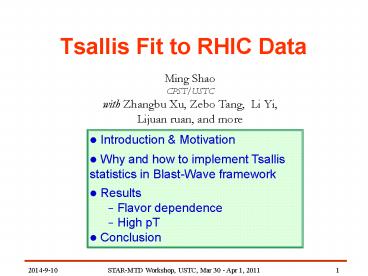Tsallis Fit to RHIC Data - PowerPoint PPT Presentation
1 / 25
Title:
Tsallis Fit to RHIC Data
Description:
Title: PowerPoint Presentation Author: yl Last modified by: nbstar Created Date: 1/1/1601 12:00:00 AM Document presentation format: On-screen Show (4:3) – PowerPoint PPT presentation
Number of Views:77
Avg rating:3.0/5.0
Title: Tsallis Fit to RHIC Data
1
Tsallis Fit to RHIC Data
Ming Shao CPST/USTC with Zhangbu Xu, Zebo Tang,
Li Yi, Lijuan ruan, and more
- Introduction Motivation
- Why and how to implement Tsallis statistics in
Blast-Wave framework - Results
- Flavor dependence
- High pT
- Conclusion
2
Thermalization and Radial flow in HI
STAR whitepaper
Phys. Rev. Lett. 92 (2004) 182301
Thermalization in heavy-ion collisions
? -particle ratios agree with thermal
prediction Matter flows in heavy-ion collisions
all particles have the same collective velocity
3
Blast-wave analysis
Multi-strange decouple earlier than light
hadrons, with less radial flow velocity
4
Hydrodynamics evolution
p, K, p
Multi-strange W
Hydro parameters ?0 0.6 fm/c s0 110 fm-3
s0/n0 250 TcritTchem165 MeV Tdec100 MeV
Ulrich Heinz, arXiv0901.4355
Multi-strange particle spectra can be well
described by the same hydrodynamics parameters as
light hadrons ?in contrast to the Blast-wave
results
4
5
Blast-Wave Model
- Assumptions
- Local thermal equilibrium ? Boltzmann
distribution - Longitudinal and transverse expansions (12)
- Temperature and ??T? are global quantities
BGBW Boltzmann-Gibbs Blast-Wave
5
6
Limitation of the Blast-wave
STAR PRC71 (2005) 64902
- Strong assumption on local thermal equilibrium
- Arbitrary choice of pT range of the spectra
- Non-zero flow velocity ltbTgt0.2 in pp
- Lack of non-extensive quantities to describe the
evolution from pp to central AA collisions - mT spectra in pp collisions
- Levy function or mT power-law
- mT spectra in AA collisions
- Boltzmann or mT exponential
AuAu_at_200GeV
pp_at_200GeV minbias
6
7
Non-extensive Tsallis statistics
C. Tsallis, H. Stat. Phys. 52, 479 (1988)
Wilk and Wlodarzcyk, PRL84, 2770 (2000) Wilk
and Wlodarzcyk, EPJ40, 299 (2009)
Tsallis Entropy
- Why Tsallis statistics?
- Memory effect
- Long range correlation (small size)
- Intrinsic fluctuation
- Limited phase space
8
Tsallis statistics in Blast-wave model
BGBW
With Tsallis distribution
Tsallis Blast-wave (TBW) equation is
9
Fit results in AuAu collisions
ZBT,Yichun Xu, Lijuan Ruan, Gene van Buren,
Fuqiang Wang and Zhangbu Xu, Phys. Rev. C 79,
051901 (R) (2009)
9
10
Results in pp collisions
10
11
Fit strange hadrons only
All available species
Strangeness, AuAu 0-10 ltbgt 0.464 - 0.006
T 0.150 - 0.005 q 1.000 -
0.002 chi2/nDof 51/99
TstrangegtTlight-hadrons Strangness decouple from
the system earlier
11
12
Centrality dependence for T and ltbTgt
- Multi-strange hadrons decouple earlier
- Hadron rescattering at hadronic phase doesnt
produce a collective radial flow, instead, it
drives the system off equilibrium - Partons achieve thermal equilibrium in central
collisions
12
13
J/y suppression at RHIC and SPS
- quarkonium gloden probe of QGP
- deconfinement (color screening)
- thermometer
13
14
J/y radial flow
J/y radial flow consistent with 0, inconsistent
with regeneration
AuAu ß0, T0.2/-0.4, q-10.06/-0.18 CuCu
ß0, T0.0/-0.4, q-11.113/-0.006 pp
ß0, T0.17/-0.17, q-11.07/-0.05
14
15
Tsallis fit to high-pT
corona (pp)
core
16
RAA v2
1) New extension to v2 still provide high quality
fits indicating bulk as a thermodynamic state.
2) Non-equilibrated component in the core
produces a power-law tail in spectra and high v2
at the intermediate pT. 3) The baryon and meson
yields are grouped in pp. 4) 2)3) together
bring down the bulk v2, produce the baryon
enhancement and the NCQ scaling at the
intermediate pT. 5) The medium quenches the jet
(to fpp 0.40), resulting in a finite v2
emission (9.4). 6) Data points at low pT
dominates the fit ?2.
17
Summary
- Identified particle spectra at RHIC have been
analyzed with Tsallis statistics in Blast-wave
description to high pT - (light hadrons, multi-strange hadrons,
charmonium) - Partonic phase
- Partons achieve thermal equilibrium in central
heavy-ion collisions - J/y is not thermalized and disfavors regeneration
- Hadronic phase
- Multi-strange hadrons decouple earlier
- Hadronic rescattering doesnt produce collective
radial flow, but drives the system off
equilibrium - Radial flow reflects that when the multi-strange
decouples - Unified macroscopic description of hadron
spectra/flow to high pT - Core and corona component
- Statistical originated NCQ scaling on RAA v2
17
18
Thank you!
18
19
Check Parameter Correlation
ltbgt 0.0954 - 0.0828 T 0.1777 -
0.0328 q 1.0106 - 0.0022 c2/nDof 151.53
/ 37
ltbgt 0.0000 - 0.0000 T 0.1747 -
0.1644 q 1.0708 - 0.0435 c2/nDof 12.83
/ 13
19
20
CheckStrangeness and light hadrons
20
21
Temperature fluctuation
Reverse legend
Wilk and Wlodarzcyk, EPJ40, 299 (2009) Wilk and
Wlodarzcyk, PRL84, 2770 (2000)
1/14/2010
21
22
J/y Elliptic flow
J/y
Heavy Flavor decay electron
Alan Dion, QM2009
Too early to compare with models Wont have
enough statistics before 2011
Ermias T. Atomssa, QM2009
22
23
How about radial flow?
Sizeable radial flow for heavy flavor decay
electrons
Yifei Zhang, QM2008, STAR, arXiv0805.0364
(submitted to PRL)
23
24
Beam energy dependence
- The radial flow velocity at SPS is smaller than
that at RHIC. - Freeze-out temperatures are similar at RHIC and
SPS. - The non-equilibrium parameter (q-1) is small in
central nucleus-nucleus collisions at RHIC and
SPS except a larger (q -1) value for non-strange
hadrons at RHIC energy
24
25
J/y radial flow
25































